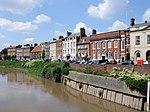Walsoken railway station
Disused railway stations in NorfolkFormer Great Eastern Railway stationsPages with no open date in Infobox stationRailway stations in Great Britain closed in 1851Railway stations in Great Britain opened in 1848 ... and 1 more
Use British English from April 2017
Walsoken railway station was located on the line between Wisbech East and Emneth. It served the village and parish of Walsoken in Norfolk, England, and closed in 1851. Today there is no trace of the station or the railway as the site has been redeveloped with housing.
Excerpt from the Wikipedia article Walsoken railway station (License: CC BY-SA 3.0, Authors).Walsoken railway station
Meadowgate Lane, Fenland District
Geographical coordinates (GPS) Address Phone number Website Nearby Places Show on map
Geographical coordinates (GPS)
| Latitude | Longitude |
|---|---|
| N 52.6577 ° | E 0.1754 ° |
Address
Meadowgate Academy
Meadowgate Lane
PE13 2JH Fenland District
England, United Kingdom
Open on Google Maps










